Spatial–Temporal Evolution and Improvement Measures of Embodied Carbon Emissions in Interprovincial Trade for Coal Energy Supply Bases: Case Study of Anhui, China
Abstract
:1. Introduction
2. Study Area
3. Materials and Methods
3.1. MRIO Model
3.2. ECEs-IPT Estimation Model
3.3. Coupling Relationship (CR) Model
3.4. Data Sources
4. Results
4.1. Changes in the Net ECEs-IPT Outflow in Anhui among the YREB
4.2. Spatial–Temporal Evolution of the Net ECEs-IPT Outflow in Anhui among the YREB
4.3. Industry Sectors Characteristics of Net ECEs-IPT Outflow in Anhui among the YREB
5. Discussion
5.1. Improvement Measures for ECEs-IPT Reduction of Different Industry Sectors
5.1.1. Classification for Industry Sector by CR Model
5.1.2. Improvement Measures for Different Industrial Types
5.2. Further Improvement Measures of Different Target Provinces in Major Industry Sectors
5.2.1. Improvement Measures for ElecMachinery
5.2.2. Improvement Measures for Coalmin
5.2.3. Improvement Measures for NonMProd
6. Conclusions
Supplementary Materials
Author Contributions
Funding
Institutional Review Board Statement
Informed Consent Statement
Data Availability Statement
Conflicts of Interest
References
- IPCC. Climate Change 2022: Impacts, Adaptation and Vulnerability; Contribution of Working Group II to the Sixth Assessment Report of the Intergovernmental Panel on Climate Change, Ed.; Cambridge University Press: Cambridge, UK, 2022. [Google Scholar]
- Jägermeyr, J.; Müller, C.; Ruane, A.C.; Elliott, J.; Balkovic, J.; Castillo, O.; Rosenzweig, C. Climate impacts on global agriculture emerge earlier in new generation of climate and crop models. Nat. Food 2021, 2, 873–885. [Google Scholar] [CrossRef]
- Chen, S.; Chen, B.; Feng, K.; Liu, Z.; Fromer, N.; Tan, X.; Hubacek, K. Physical and virtual carbon metabolism of global cities. Nat. Commun. 2020, 11, 1–11. [Google Scholar] [CrossRef] [PubMed] [Green Version]
- Hong, C.; Zhang, Q.; Zhang, Y.; Davis, S.J.; Tong, D.; Zheng, Y.; Schellnhuber, H.J. Impacts of climate change on future air quality and human health in China. Proc. Natl. Acad. Sci. USA 2019, 116, 17193–17200. [Google Scholar] [CrossRef] [PubMed] [Green Version]
- Dong, S.; Wang, Z.; Li, Y.; Li, F.; Li, Z.; Chen, F.; Cheng, H. Assessment of comprehensive effects and optimization of a circular economy system of coal power and cement in Kongtong District, Pingliang City, Gansu Province, China. Sustainability 2017, 9, 787. [Google Scholar] [CrossRef] [Green Version]
- Wang, C.; Zhao, Y.; Wang, Y.; Wood, J.; Kim, C.Y.; Li, Y. Transportation CO2 emission decoupling: An assessment of the Eurasian logistics corridor. Transp. Res. Part D Transp. Environ. 2020, 86, 102486. [Google Scholar] [CrossRef]
- Tian, K.; Zhang, Y.; Li, Y.; Ming, X.; Jiang, S.; Duan, H.; Wang, S. Regional trade agreement burdens global carbon emissions mitigation. Nat. Commun. 2022, 13, 1–12. [Google Scholar] [CrossRef]
- Cheng, H.; Dong, S.; Li, F.; Yang, Y.; Li, S.; Li, Y. Multiregional input-output analysis of spatial-temporal evolution driving force for carbon emissions embodied in interprovincial trade and optimization policies: Case study of northeast industrial district in China. Environ. Sci. Technol. 2018, 52, 346–358. [Google Scholar] [CrossRef]
- Chen, Z.; Ni, W.; Xia, L.; Zhong, Z. Structural decomposition analysis of embodied carbon in trade in the middle reaches of the Yangtze River. Environ. Sci. Pollut. Res. 2019, 26, 816–832. [Google Scholar] [CrossRef]
- Clarke-Sather, A.; Qu, J.; Wang, Q.; Zeng, J.; Li, Y. Carbon inequality at the sub-national scale: A case study of provincial-level inequality in CO2 emissions in China 1997–2007. Energy Policy 2011, 39, 5420–5428. [Google Scholar] [CrossRef]
- Liu, H.; Liu, W.; Fan, X.; Liu, Z. Carbon emissions embodied in value added chains in China. J. Clean. Prod. 2015, 103, 362–370. [Google Scholar] [CrossRef]
- Li, F. Progress and prospects of research on transfer of carbon emissions embodied in inter-regional trade. Prog. Geogr. 2018, 37, 1303–1313. (In Chinese) [Google Scholar]
- Balistreri, E.J.; Kaffine, D.T.; Yonezawa, H. Optimal environmental border adjustments under the General Agreement on Tariffs and Trade. Environ. Resour. Econ. 2019, 74, 1037–1075. [Google Scholar] [CrossRef] [Green Version]
- Ji, X.; Liu, Y.; Han, M.; Meng, J. The mutual benefits from Sino-Africa trade: Evidence on emission transfer along the global supply chain. J. Environ. Manag. 2020, 263, 110332. [Google Scholar] [CrossRef] [PubMed]
- Hou, J.; Deng, X.; Springer, C.H.; Teng, F. A global analysis of CO2 and non-CO2 GHG emissions embodied in trade with Belt and Road Initiative countries. Ecosyst. Health Sustain. 2020, 6, 1761888. [Google Scholar] [CrossRef]
- Wood, R.; Neuhoff, K.; Moran, D.; Simas, M.; Grubb, M.; Stadler, K. The structure, drivers and policy implications of the European carbon footprint. Clim. Policy 2020, 20 (Suppl. S1), S39–S57. [Google Scholar] [CrossRef] [Green Version]
- Cai, X.; Che, X.; Zhu, B.; Zhao, J.; Xie, R. Will developing countries become pollution havens for developed countries? An empirical investigation in the Belt and Road. J. Clean. Prod. 2018, 198, 624–632. [Google Scholar] [CrossRef]
- Li, Y.; Sun, L.; Zhang, H.; Liu, T.; Fang, K. Does industrial transfer within urban agglomerations promote dual control of total energy consumption and energy intensity? J. Clean. Prod. 2018, 204, 607–617. [Google Scholar] [CrossRef]
- Zhang, X.; Zhao, T.; Wang, J.; Wei, Y. The embodied CO2 transfer across sectors of cities in Jing-Jin-Ji region: Combining multi-regional input–output analysis with complex network analysis. Environ. Sci. Pollut. Res. 2021, 28, 44249–44263. [Google Scholar] [CrossRef]
- Yang, Y.; Dong, S.; Li, F.; Cheng, H.; Li, Z.; Li, Y.; Li, S. An analysis on the adoption of an interregional carbon emission reduction allocation approach in the context of China’s interprovincial carbon emission transfer. Environ. Dev. Sustain. 2021, 23, 4385–4411. [Google Scholar] [CrossRef]
- Yuan, X.; Sheng, X.; Chen, L.; Tang, Y.; Li, Y.; Jia, Y.; Zuo, J. Carbon footprint and embodied carbon transfer at the provincial level of the Yellow River Basin. Sci. Total Environ. 2022, 803, 149993. [Google Scholar] [CrossRef]
- Liu, Y.; Li, J.; Yang, Y. Strategic adjustment of land use policy under the economic transformation. Land Use Policy 2018, 74, 5–14. [Google Scholar] [CrossRef]
- Xiao, R.; Tan, G.; Huang, B.; Li, J.; Luo, Y. Pathways to sustainable development: Regional integration and carbon emissions in China. Energy Rep. 2022, 8, 5137–5145. [Google Scholar] [CrossRef]
- Lu, Y.; Zhang, Y.; Cao, X.; Wang, C.; Wang, Y.; Zhang, M.; Zhang, Z. Forty years of reform and opening up: China’s progress toward a sustainable path. Sci. Adv. 2019, 5, eaau9413. [Google Scholar] [CrossRef] [PubMed] [Green Version]
- Yang, Y.; Liu, Y.; Li, Y.; Li, J. Measure of urban-rural transformation in Beijing-Tianjin-Hebei region in the new millennium: Population-land-industry perspective. Land Use Policy 2018, 79, 595–608. [Google Scholar] [CrossRef]
- Ma, W.; Jiang, G.; Chen, Y.; Qu, Y.; Zhou, T.; Li, W. How feasible is regional integration for reconciling land use conflicts across the urban–rural interface? Evidence from Beijing–Tianjin–Hebei metropolitan region in China. Land Use Policy 2020, 92, 104433. [Google Scholar] [CrossRef]
- Chen, Y.; Zhang, S.; Huang, D.; Li, B.L.; Liu, J.; Liu, W.; Wang, H. The development of China’s Yangtze River Economic Belt: How to make it in a green way. Sci. Bull. 2017, 62, 648–651. [Google Scholar] [CrossRef] [Green Version]
- Tian, Y.; Sun, C. Comprehensive carrying capacity, economic growth and the sustainable development of urban areas: A case study of the Yangtze River Economic Belt. J. Clean. Prod. 2018, 195, 486–496. [Google Scholar] [CrossRef]
- Hui, E.C.; Li, X.; Chen, T.; Lang, W. Deciphering the spatial structure of China’s megacity region: A new bay area—The Guangdong-Hong Kong-Macao Greater Bay Area in the making. Cities 2020, 105, 102168. [Google Scholar] [CrossRef]
- Gao, X.; Zhang, A.; Sun, Z. How regional economic integration influence on urban land use efficiency? A case study of Wuhan metropolitan area, China. Land Use Policy 2020, 90, 104329. [Google Scholar] [CrossRef]
- Tang, L.; He, G. How to improve total factor energy efficiency? An empirical analysis of the Yangtze River economic belt of China. Energy 2021, 235, 121375. [Google Scholar] [CrossRef]
- Liu, J.; Tian, Y.; Huang, K.; Yi, T. Spatial-temporal differentiation of the coupling coordinated development of regional energy-economy-ecology system: A case study of the Yangtze River Economic Belt. Ecol. Indic. 2021, 124, 107394. [Google Scholar] [CrossRef]
- Wang, P.; Wu, J. Impact of environmental investment and resource endowment on regional energy efficiency: Evidence from the Yangtze River Economic Belt, China. Environ. Sci. Pollut. Res. 2022, 29, 5445–5453. [Google Scholar] [CrossRef]
- Yu, S.; Wei, Y.M.; Fan, J.; Zhang, X.; Wang, K. Exploring the regional characteristics of inter-provincial CO2 emissions in China: An improved fuzzy clustering analysis based on particle swarm optimization. Appl. Energy 2012, 92, 552–562. [Google Scholar] [CrossRef]
- Yang, N.; Tang, S.; Zhang, S.; Huang, W.; Chen, P.; Chen, Y.; Wang, K. Fluorine in Chinese coal: A review of distribution, abundance, modes of occurrence, genetic factors and environmental effects. Minerals 2017, 7, 219. [Google Scholar] [CrossRef] [Green Version]
- Zhu, A.; Wang, Q.; Liu, D.; Zhao, Y. Analysis of the characteristics of CH4 emissions in China’s coal mining industry and research on emission reduction measures. Int. J. Environ. Res. Public Health 2022, 19, 7408. [Google Scholar] [CrossRef] [PubMed]
- Wang, R.; Liu, W.; Xiao, L.; Liu, J.; Kao, W. Path towards achieving of China’s 2020 carbon emission reduction target—A discussion of low-carbon energy policies at province level. Energy Policy 2011, 39, 2740–2747. [Google Scholar] [CrossRef]
- International Energy Agency. World Energy Balances 2016; IEA Publications: Paris, France, 2016. [Google Scholar]
- International Energy Agency. China’s Engagement in Global Energy Governance; IEA Publications: Paris, France, 2016. [Google Scholar]
- Ang, B.W.; Wang, H. Index decomposition analysis with multidimensional and multilevel energy data. Energy Econ. 2015, 51, 67–76. [Google Scholar] [CrossRef]
- Chen, Z.M.; Chen, G.Q.; Chen, B. Embodied carbon dioxide emissions of the world economy: A systems input-output simulation for 2004. Procedia Environ. Sci. 2010, 2, 1827–1840. [Google Scholar] [CrossRef] [Green Version]
- Zhao, N.; Xu, L.X.; Malik, A.; Song, X.G.; Wang, Y.F. Inter-provincial trade driving energy consumption in China. Resour. Conserv. Recycl. 2018, 134, 329–335. [Google Scholar] [CrossRef]
- Ministry of Natural Resources, PRC. 2022 China Mineral Resources; Geological Publishing House: Beijing, China, 2022; p. 18.
- The CPC Central Committee. The State Council, P.R.C. Outline of the Yangtze River Delta Regional Integrated Development Plan; The CPC Central Committee: Beijing, China, 2019. (In Chinese)
- The CPC Anhui Provincial Committee. Suggestions of the CPC Anhui Provincial Committee on Formulating the 14th Five-Year Plan and Long-Term Goals for National Economic and Social Development; The CPC Anhui Provincial Committee: Hefei, China, 2020. (In Chinese)
- Kuznets, S. The Structure of the American Economy, 1919–1929. By Wassily W. Leontief. Harvard University Press: Cambridge, UK, 1941. pp. xi, 181. $2.50. J. Econ. Hist. 1941, 1, 246. [Google Scholar] [CrossRef]
- Leontief, W. Environmental repercussions and the economic structure: An input-output approach. Rev. Econ. Stat. 1970, 52, 262–271. [Google Scholar] [CrossRef]
- Lin, B.; Sun, C. Evaluating carbon dioxide emissions in international trade of China. Energy Policy 2010, 38, 613–621. [Google Scholar] [CrossRef]
- Li, S.; Qi, S.; He, J. China Regional Expansion Input-Output Table in 2007: Preparation and Application; Economic Science Press: Beijing, China, 2016. (In Chinese) [Google Scholar]
- Li, S.; Pan, C.; He, J. China Regional Expansion Input-Output Table in 2017: Preparation and application; Economic Science Press: Beijing, China, 2021. (In Chinese) [Google Scholar]
- IPCC. IPCC Guidelines for National Greenhouse Gas Inventories; IGES: Kanagawa, Japan, 2006. [Google Scholar]
- Peters, G.P.; Weber, C.; Liu, J. Construction of Chinese Energy and Emissions Inventory; NTNU: Trondheim, Norway, 2006. [Google Scholar]
- National Bureau of Statistics of the People’s Republic of China. Energy Statistics Knowledge Manual; China Statistics Press: Beijing, China, 2006.


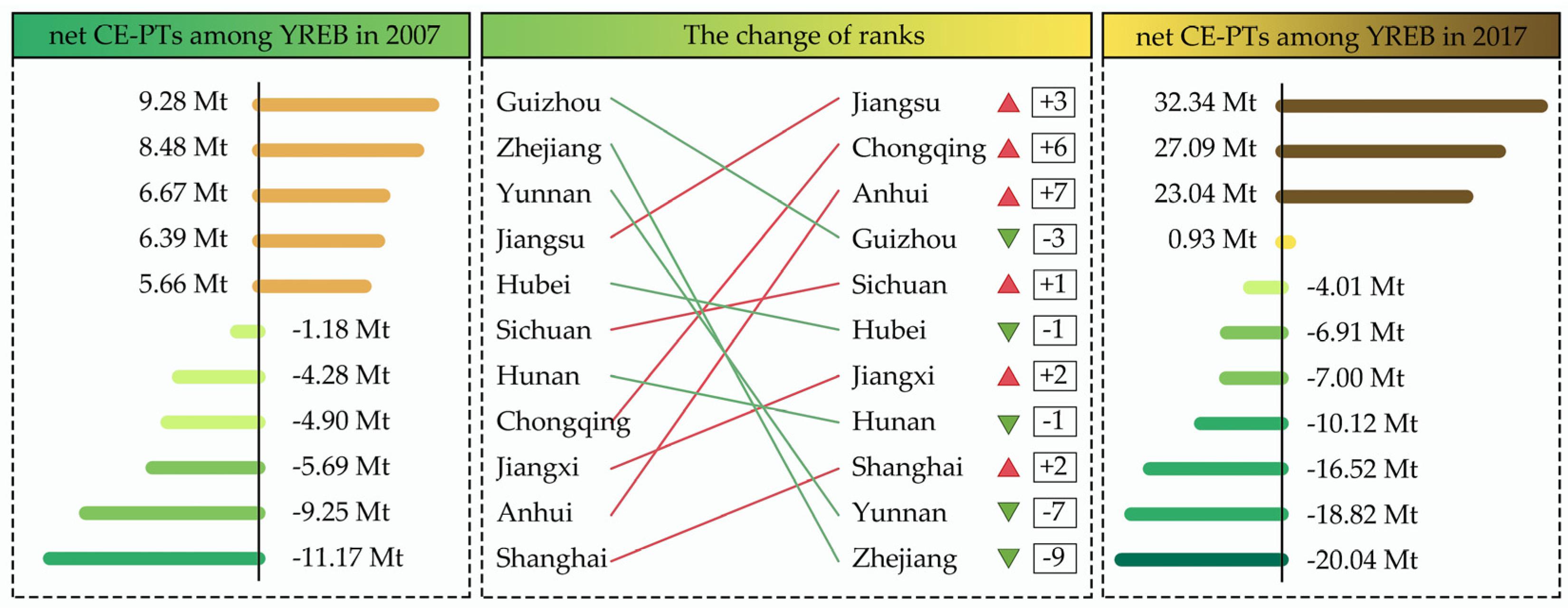
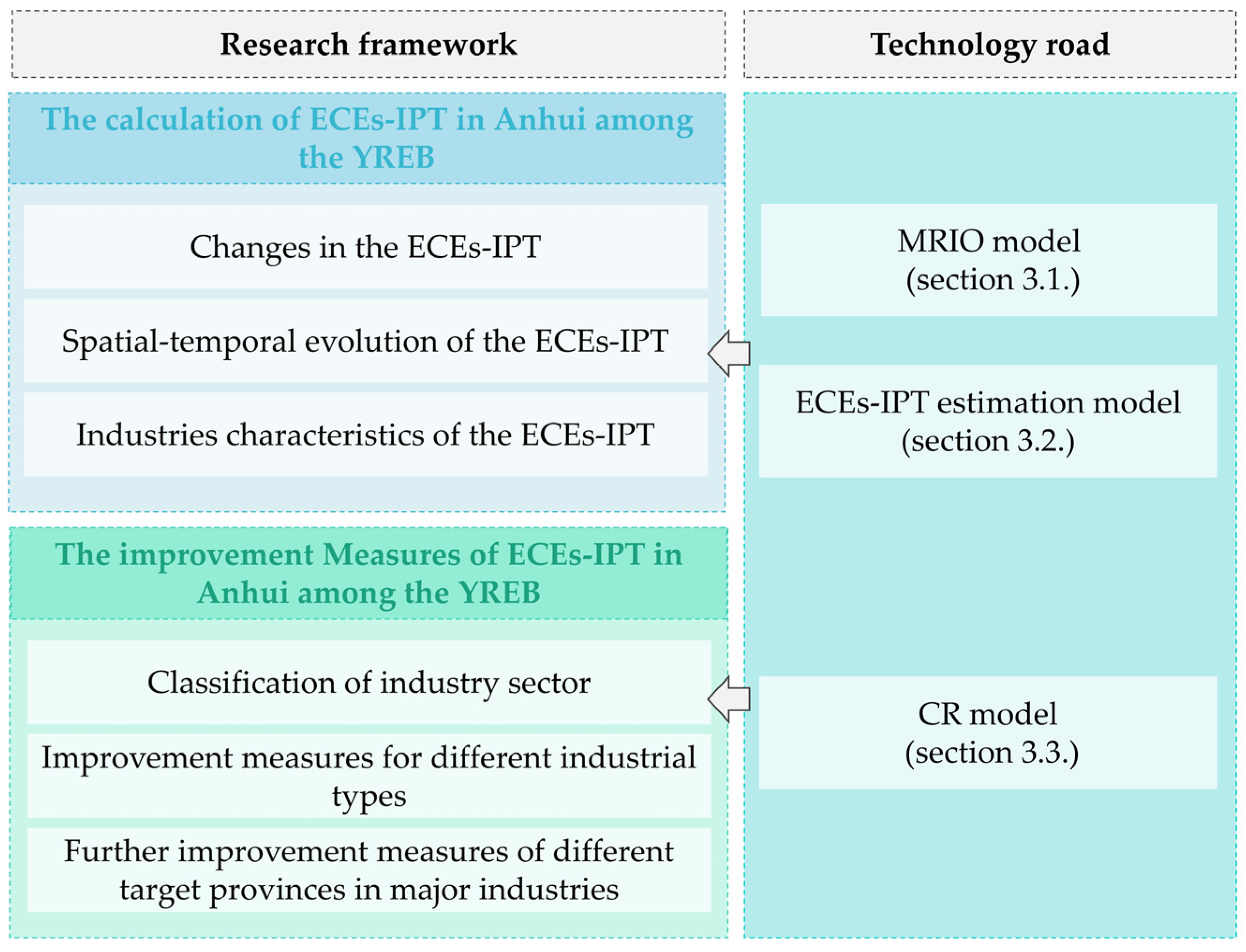
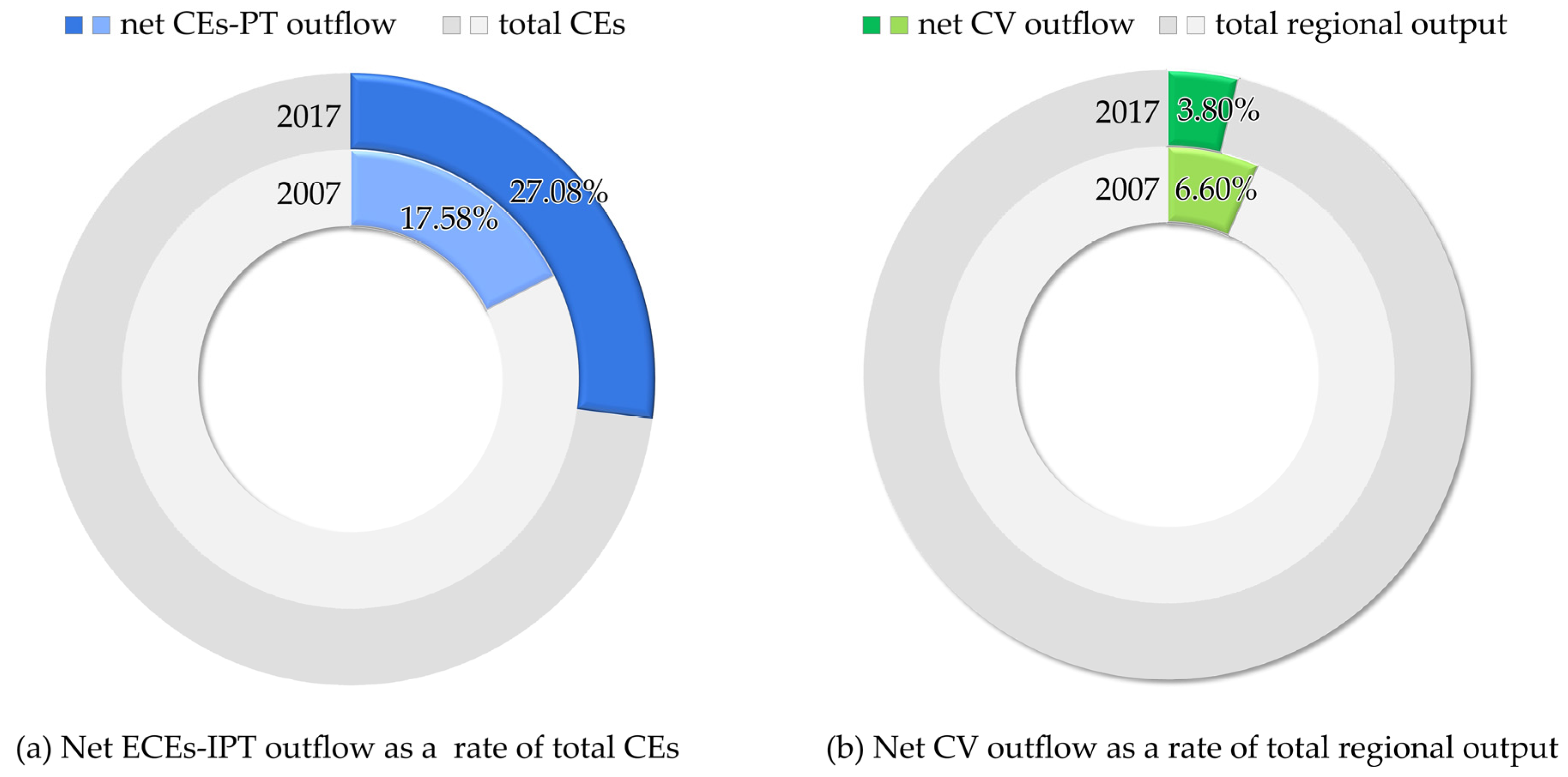

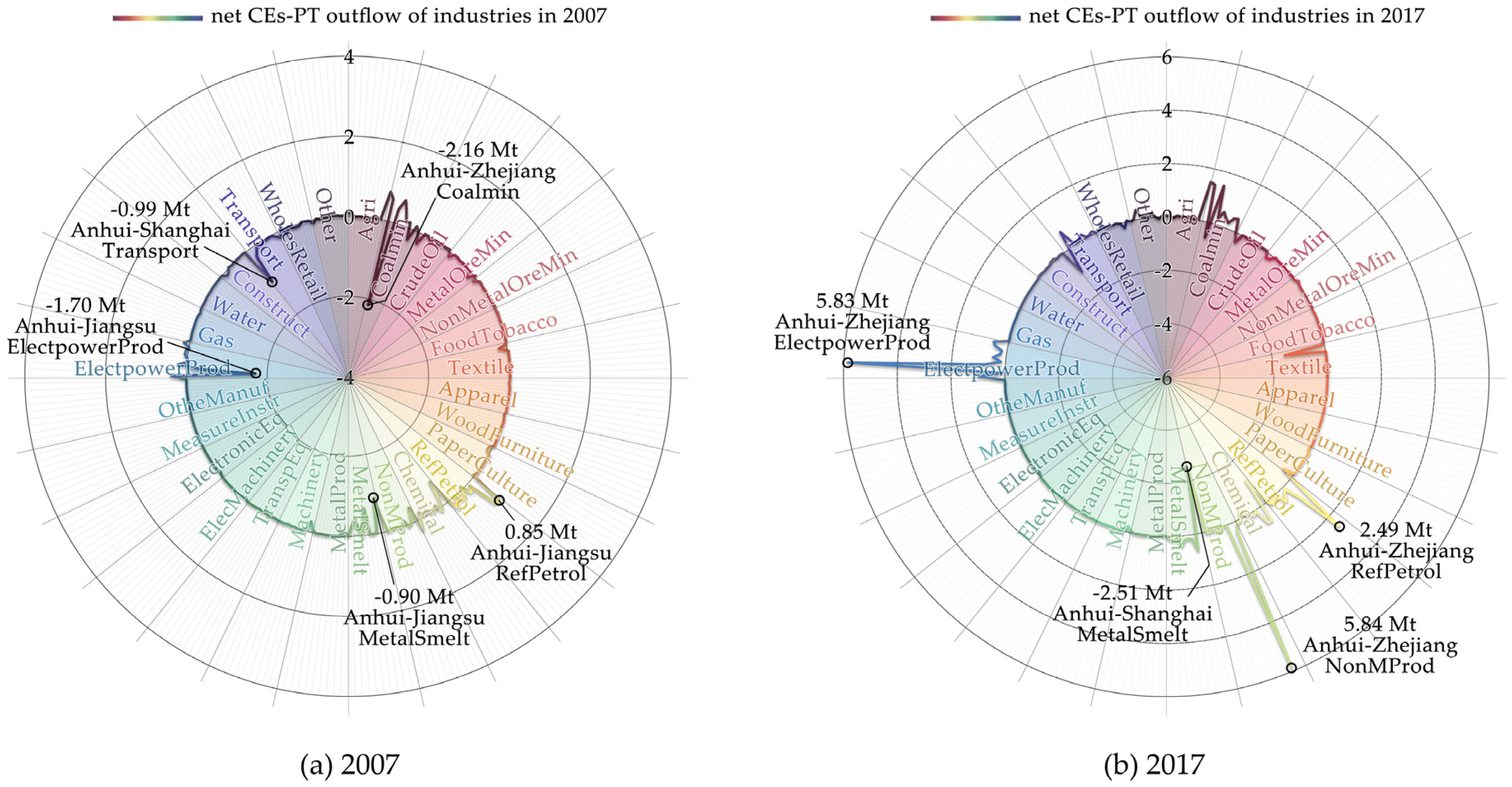
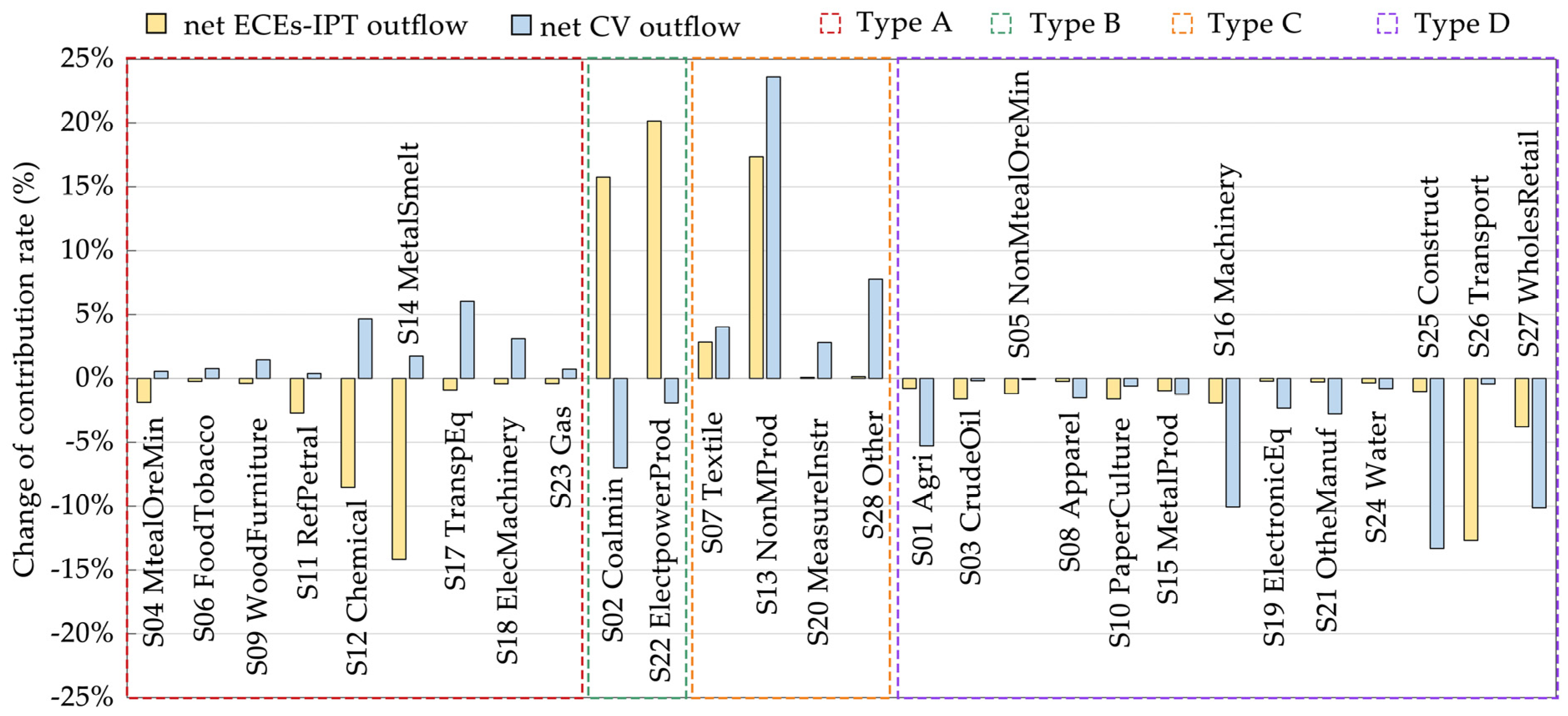


| Intermediate Use | Interprovincial Outflow from Region r | ||||||||||||
|---|---|---|---|---|---|---|---|---|---|---|---|---|---|
| region r | industry sector | ⋯ | ⋯ | final use | Total output | ⋯ | ⋯ | ||||||
| intermediate input | ⋯ | ⋯ | ⋯ | ⋯ | |||||||||
| ⋮ | ⋮ | ⋮ | ⋮ | ⋮ | ⋮ | ⋮ | ⋮ | ⋮ | |||||
| ⋯ | ⋯ | ⋯ | ⋯ | ||||||||||
| ⋮ | ⋮ | ⋮ | ⋮ | ⋮ | ⋮ | ⋮ | ⋮ | ⋮ | |||||
| ⋯ | ⋯ | ⋯ | ⋯ | ||||||||||
| value-added | ⋯ | . | ⋯ | ||||||||||
| total input | ⋯ | ⋯ | |||||||||||
| interprovincial inflow into region r | ⋯ | ⋯ | |||||||||||
| ⋮ | ⋮ | ⋮ | ⋮ | ||||||||||
| ⋯ | ⋯ | ||||||||||||
| ⋮ | ⋮ | ⋮ | ⋮ | ||||||||||
| ⋯ | ⋯ | ||||||||||||
Publisher’s Note: MDPI stays neutral with regard to jurisdictional claims in published maps and institutional affiliations. |
© 2022 by the authors. Licensee MDPI, Basel, Switzerland. This article is an open access article distributed under the terms and conditions of the Creative Commons Attribution (CC BY) license (https://creativecommons.org/licenses/by/4.0/).
Share and Cite
Zhang, M.; Dong, S.; Li, F.; Xu, S.; Guo, K.; Liu, Q. Spatial–Temporal Evolution and Improvement Measures of Embodied Carbon Emissions in Interprovincial Trade for Coal Energy Supply Bases: Case Study of Anhui, China. Int. J. Environ. Res. Public Health 2022, 19, 17033. https://doi.org/10.3390/ijerph192417033
Zhang M, Dong S, Li F, Xu S, Guo K, Liu Q. Spatial–Temporal Evolution and Improvement Measures of Embodied Carbon Emissions in Interprovincial Trade for Coal Energy Supply Bases: Case Study of Anhui, China. International Journal of Environmental Research and Public Health. 2022; 19(24):17033. https://doi.org/10.3390/ijerph192417033
Chicago/Turabian StyleZhang, Menghan, Suocheng Dong, Fujia Li, Shuangjie Xu, Kexin Guo, and Qian Liu. 2022. "Spatial–Temporal Evolution and Improvement Measures of Embodied Carbon Emissions in Interprovincial Trade for Coal Energy Supply Bases: Case Study of Anhui, China" International Journal of Environmental Research and Public Health 19, no. 24: 17033. https://doi.org/10.3390/ijerph192417033






